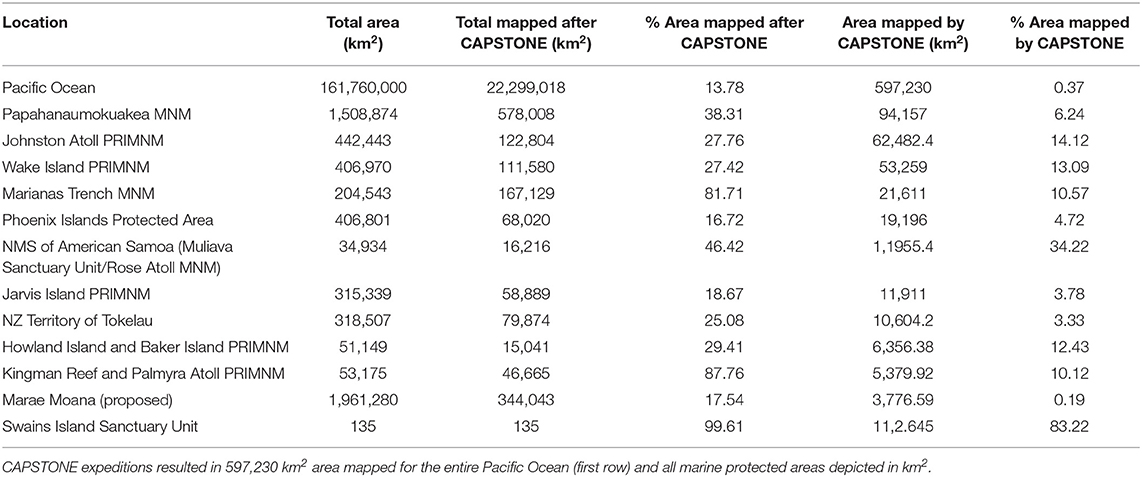Corrigendum: The Unknown and the Unexplored: Insights Into the Pacific Deep-Sea Following NOAA CAPSTONE Expeditions
- 1Department of Biology, Boston University, Boston, MA, United States
- 2NOAA Office of Ocean Exploration and Research, Silver Spring, MD, United States
- 3MAXIMUS, Metro Center, Reston, VA, United States
- 4University of Hawai'i at Manoa Joint Institute of Marine and Atmospheric Research (JIMAR), Honolulu, HI, United States
- 5Bureau of Ocean Energy Management, Camarillo, CA, United States
- 6Cherokee Nation Strategic Programs, Richmond Hwy Suite, Arlington, TX, United States
- 7Athenium Analytics, Dover, DE, United States
- 8Department of Biology, University of Louisiana at Lafayette, Lafayette, LA, United States
- 9Department of Biology, Temple University, Philadelphia, PA, United States
- 10Department of Invertebrate Zoology, National Museum of Natural History, Smithsonian Institution, Washington, DC, United States
A Corrigendum on
The Unknown and the Unexplored: Insights Into the Pacific Deep-Sea Following NOAA CAPSTONE Expeditions
by Kennedy, B. R. C., Cantwell, K., Malik, M., Kelley, C., Potter, J., Elliott, K., et al. (2019). Front. Mar. Sci. 6:480. doi: 10.3389/fmars.2019.00480
In the original article, there were three typographical errors. The number of hours of ROV video collected was incorrectly listed as 189 in two places in the article when it should have been 891.5 hours. These two typos were in the text only. All figures, effort correction calculations and conclusions were based on the correct number. There was a third, additional error in Table 2: Howland Island and Baker Island were listed as being a PRINMS when in fact it should have read PRIMNM.

Table 2. CAPSTONE multibeam mapping accomplishments after 3 years of effort by the Okeanos Explorer.
A correction has been made to the abstract.
Corrected paragraph: Over a 3-year period, the National Oceanic and Atmospheric Administration (NOAA) organized and implemented a Pacific-wide field campaign entitled CAPSTONE: Campaign to Address Pacific monument Science, Technology, and Ocean NEeds. Under the auspices of CAPSTONE, NOAA mapped 597,230 km2 of the Pacific seafloor (with ~61% of mapped area located within US waters), including 323 seamounts, conducted 187 ROV dives totaling 891.5 h of ROV benthic imaging time, and documented >347,000 individual organisms. This comprehensive effort yielded dramatic insight into differences in biodiversity across depths, regions, and features, at multiple taxonomic scales. For all deep sea taxonomic groups large enough to be visualized with the ROV, we found that fewer than 20% of the species were able to be identified. The most abundant and highest diversity taxa across the dataset were from three phyla (Cnidaria, Porifera, and Echinodermata). We further examined these phyla for taxonomic assemblage patterns by depth, geographic region, and geologic feature. Within each taxa, there were multiple genera with specific distribution and abundance by depth, region, and feature. Additionally, we observed multiple genera with broad abundance and distribution, which may focus future ecological research efforts. Novel taxa, records, and behaviors were observed, suggestive of many new types of species interactions, drivers of community composition, and overall diversity patterns. To date, only 13.8% of the Pacific has been mapped using modern methods. Despite the incredible amount of new known and unknown information about the Pacific deep-sea, CAPSTONE is far from the culminating experience the name suggests. Rather, it marks the beginning of a new era for exploration that will offer extensive opportunities via mapping, technology, analysis, and insights.
A correction has been made to the Discussion, Paragraph 14 (last paragraph):
Ironically named, CAPSTONE is more of a beginning than a culminating experience. It is the launch of decades of data-mining, visual analyses, hypothesis-generation, and justification for future exploration. The trends highlighted in this paper offer a snapshot of what is known, and what remains unknown, in the Pacific Ocean. What we have learned from 3 years and 891.5 h on the seafloor is that the Pacific is not just a place of historical exploration and voyaging: it is a place that offers extensive opportunities for technology innovations, and insights. In other words, it is a place for future discovery.
Additionally, there was a mistake in Table 2. Row 11 should read Howland Island and Baker Island PRIMNM. The corrected Table 2 appears above.
The authors apologize for these errors and state that these changes do not alter the scientific conclusions of the article in any way. The original article has been updated.
Keywords: ocean exploration, multibeam mapping, biodiversity, seamounts, Okeanos Explorer, Anthozoa, Porifera, Echinodermata
Citation: Kennedy BRC, Cantwell K, Malik M, Kelley C, Potter J, Elliott K, Lobecker E, Gray LM, Sowers D, White MP, France SC, Auscavitch S, Mah C, Moriwake V, Bingo SRD, Putts M and Rotjan RD (2020) Corrigendum: The Unknown and the Unexplored: Insights Into the Pacific Deep-Sea Following NOAA CAPSTONE Expeditions. Front. Mar. Sci. 6:827. doi: 10.3389/fmars.2019.00827
Received: 18 November 2019; Accepted: 23 December 2019;
Published: 18 February 2020.
Edited by:
Cinzia Corinaldesi, Marche Polytechnic University, ItalyReviewed by:
Pedro A. Ribeiro, University of Bergen, NorwayCopyright © 2020 Kennedy, Cantwell, Malik, Kelley, Potter, Elliott, Lobecker, Gray, Sowers, White, France, Auscavitch, Mah, Moriwake, Bingo, Putts and Rotjan. This is an open-access article distributed under the terms of the Creative Commons Attribution License (CC BY). The use, distribution or reproduction in other forums is permitted, provided the original author(s) and the copyright owner(s) are credited and that the original publication in this journal is cited, in accordance with accepted academic practice. No use, distribution or reproduction is permitted which does not comply with these terms.
*Correspondence: Brian R. C. Kennedy, kennedyb@bu.edu; Randi D. Rotjan, rrotjan@bu.edu
 Brian R. C. Kennedy
Brian R. C. Kennedy Kasey Cantwell
Kasey Cantwell Mashkoor Malik
Mashkoor Malik Christopher Kelley2,4
Christopher Kelley2,4  Derek Sowers
Derek Sowers Scott C. France
Scott C. France Steven Auscavitch
Steven Auscavitch Christopher Mah
Christopher Mah Virginia Moriwake
Virginia Moriwake Sarah R. D. Bingo
Sarah R. D. Bingo Meagan Putts
Meagan Putts Randi D. Rotjan
Randi D. Rotjan